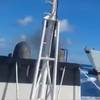Building Candies High-Performance Boats
In the new millennium, Otto Candies LLC, Des Allemands, La., has embarked on a very aggressive new building program that has seen the delivery of three 150-ft. by 50-ft. anchor handling tugs, three state of the art 240-ft. diesel/electric supply boats and now a series of six 185-ft. by 42-ft. supply boats also with diesel electric propulsion and dynamic positioning capabilities.
The three 150-ft. tugs and the three supply boats were built by Bender Shipbuilding and Repair, Mobile, Ala. For five of the six 185-ft. supply boats, Candies turned to Houma Fabricators, Houma, La., now a part of Shipyard De Hoop of the Netherlands.
Shipyard De Hoop has also built a number of foreign flagged supply and other offshore support vessels for a joint venture that Candies has with a Mexican company. Four such vessels, built in the Netherlands during the past two years, are working for the joint venture in the Yucatan area of Mexico.
The primary goal of the joint venture is to rebuild many of the rigs, platforms and undersea infrastructure of these facilities that have been allowed to deteriorate rather than resupply of existing platforms and other facilities.
Shipyard De Hoop in the Netherlands built the first of the 185-ft. vessels. Called the Caballo de Troya it is a dive support vessel and will work in western part of the Gulf of Mexico for the joint venture with the other Shipyard De Hoop-built vessels.
Delivered in October 2002, the hull of the Caballo de Troya is outfitted with compressors, air tanks and other diving equipment. It does not have the normal fuel oil, mud, water and dry bulk tanks normally associated with supply boats.
The building this vessel is a story in itself. It was built in an amazing 21 weeks from laying of the keel to delivery from Shipyard De Hoop. Candies needed the vessel quickly and De Hoop's Lobith, Holland yard put on two 10-hour shifts and used materials already on order for other Candies boats to complete the order in record time. The vessel stopped off at the Houma Fabricators yard for installation of the diving equipment before heading for Mexico.
Costing $8.5 million, the Amy Candies will be the first of the five 185-ft. supply boats to be built by Houma Fabricators and will be delivered in January. The second vessel to join the fleet will be the Milissa Candies in April 2003 and the Emily Candies, Keri Candies and Mary Frances Candies will be turned over in 2003 at approximate three month intervals after delivery of the Milissa Candies.
All five of these supply boats will be practically identical to the Caballo de Troya, except for the shape of the pilothouse deck.
"These vessels offer the ability to carry 1,700 dead weight tons and can work in deep water or the shelf, "said Brett Candies, traffic manager for Otto Candies. "We wanted to offer all of the state of the art refinements present in our 240-ft. vessels, but in a smaller OSV at a lower day rate." Diesel electric power was a feature at the top of the list for these 185-ft. supply boats.
A trio of popular Caterpillar 3508 diesels powering 910 kW generators supplies all of the power to run a pair of Rolls-Royce Ulstein Aquamaster US 155 Z-drives for propulsion power driving the vessel to 11.5 knots. A Rolls Royce 440 KW CPP tunnel thruster gives the vessel outstanding maneuverability and complies with ABS DP-2 requirements.
The installed gensets also supply electrical power for all ship's power and other non-propulsion needs. Below deck carrying capacities are generous for a 185-ft. vessel and include 110,000 gallons of fuel oil, 180,000 gallons of fresh water, 11,900 gallons of potable water 3,080 barrels of liquid mud and 3,860 cu. ft. of dry bulk material in the hull and provisions for another 3,000 cu. ft. on deck. The cargo deck aft of the main deck superstructure is 124 ft. by 33.5 ft. Layout of the vessel is very straightforward and functional. In the hull, at the forepeak are tanks for ballast and drill water, followed by the huge switchboard that controls the starting, stopping sequencing and monitoring of the three Caterpillar engines located just aft of this compartment in the engine room. This panel is by Holland's Droste Electro. The bowthruster controller is also located in this space.
Much of the hull space is devoted to six liquid mud tanks and two dry bulk tanks with the air compressor to pressure the dry bulk tanks stationed conveniently nearby. Fuel oil tanks flank the liquid mud tanks with water ballast and drill water tanks opposite the dry bulk tanks. At the stern are the two Z-drives with additional tankage for water ballast and drill water flanking the Z-drive room.
In the main deck portion of the superstructure is the galley and mess along with provisions storage and a changing room. The B deck has two four person bunks and a pair of two person accommodations. One flight up is additional accommodations spaces including a Captain's Day Room and quarters for the captain and chief engineer.
The wheelhouse dominates the D deck and is packed with navigation and communications equipment supplied by Radio Holland. The DP system is by Alstom.
Unlike the Caballo de Troya, the five vessels built in Houma, La., will be American-flagged and work in the Gulf of Mexico.
The Mexican Connection
For the past several years Otto Candies LLC has been involved a joint venture with Oceanografia S.A. DE C.V., Campeche, Mexico located on the western side of the Gulf of Mexico on the Yucatan peninsula. The venture's vessels are ported in Ciudad del Carmen, Mexico.
The Mexican firm owns nine offshore vessels of all types ranging in size from 1,080 to 4,200 kW of propulsion power. Candies have contributed new supply and crew/supply vessels of all types, many built at Shipyard De Hoop. Candies vessels in Mexico include a trio of very sophisticated Shipyard de Hoop-built supply vessels …Caballo de Trabajo, Caballo de Mar (2001 deliveries), and Caballo de Troya that recently joined the fleet. All three are diesel electric powered and feature dynamic positioning systems. All but the Caballo de Troya carry fuel oil and freshwater, but no liquid or dry mud. Their main role is to support the repair and new construction of existing platforms and subsea infrastructure.
For example the 267-ft. by 59-ft. Caballo de Trabajo (workhorse) mounts a large 100-ton crane aft, moon pool, helipad and accommodations for 118 persons in single, double and four persons cabins. It has a deadweight carrying capacity of 3,500 tons.
The slightly smaller Caballo de Mar (Seahorse) is 230 ft. by 59-ft. It has both diving and ROV moon pools, a 60-ton aft-mounted A-frame and a 45-ton crane at six meters. Like its slightly larger sister, propulsion power is via Z-drives and a pair of bow thrusters. Deadweight capacity is 2,500 short tons.
Accommodations are available for 56 persons in one and two person cabins. Otto Candies also took delivery of a pair of crew/supply boats in early 2002 from Austal USA, Mobile, Ala. Both the Veronica and the Anapaula are 150 ft. long, can carry 80 rig workers in their main deck cabin and can haul 150 tons of cargo on their aft cargo deck. Speed of the all-aluminum monohulls is 26 knots. Other Otto Candies vessels in Mexico include the Sanmar, Del Carman and a catamaran crew boat, the Seba'an. These vessels have been purpose-built to tackle the tremendous amount of construction work in the western Gulf.
Building a Shipyard While Building Boats
The past year has been an amazing one for Houma Fabricators' President & CEO O. M. "Butch" Monnier. Soon after the yard was purchased by Jan Smit, whose family has operated Shipyard De Hoop in the Netherlands for more than a century, a multi-phase facility expansion plan was put into motion. "We have been building the yard while building boats in the middle of it," Monnier said.
An $8.6 million expansion is progressing at the 42-acre site with direct access to the Intercoastal Waterway. The plan is to turn Houma Fabricators into a replica of the De Hoop shipyard in Lobith, Netherlands. Phase one has included three new steel preparation halls, four subassembly halls and a new launching system.
Phase two will dwarf the present new construction. It will include a 450-ft. by 120-ft. covered construction dock, and a 275-ft. by 200-ft. assembly hall to handle 250-ton modules … twice the size of the modules for the Amy Candies. The assembly hall will be built when customer demand calls for it.
The Houma Fabricators-Shipyard De Hoop partnership is off to a flying start with the construction of the five Candies vessels. Employment has almost doubled from 68 to 123 and the skills of the American worker have impressed Shipyard De Hoop Chairman Smit.
A year ago no one would have believed that Lobith, Netherlands and Houma, La., would forge such a productive partnership that has increased shipbuilding speed, productivity and competitiveness. More good news is likely to follow as additional contracts are announced beyond the Candies order.













